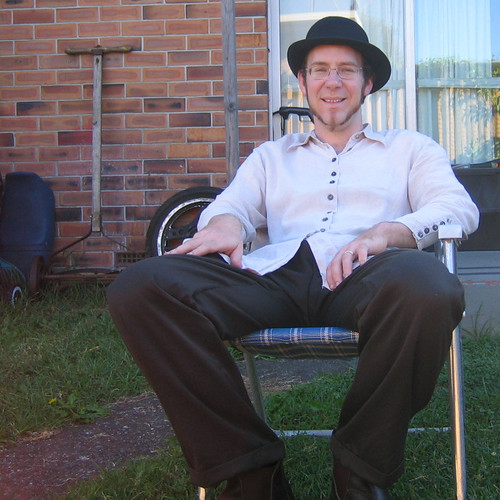
Which one needs the wheelchair?
The chair was a great success, and will be well worth the money (approx $600) if we get out a few more times each summer. No more parking the normal chair where the path ends and carrying Heather across the sand into the water. No more carrying her back up, all slippery and wet.

In the future we won't take the other wheelchair, but took it just in case yesterday. It did provide a nice place to sit and talk to Heather, while she reclined in her personal lounger.

The wheels also make a handy seat.
With its big wheels, the whole contraption floats when nobody is sitting in it. With a person sitting in it, the wheels still float but the foot end gradually sinks. We hope that a simple floatation device strapped on that end will give us a fully floating option that Heather can swim on and off.
The following video shows how smooth the process of coming out of the water was. If you're wondering why we pause, back up, and move forward again, that's me discovering where the floating wheels touch bottom and start turning. I also stop to check if it works to push from the head end, but decide that it works best to pull from the feet. We do need a handle to save stooping over and avoid lifting too high and banging poor Heather's head.
MUTE BEFORE WATCHING - NASTY STATIC
Do try this at home. Our system is cobbled together from a pair of 49cm Wheeleez Wheels (distributed in NZ by BeachWheels.co.nz) and a $50 fold-out beach lounger we were given several years ago. We bought an axle and locking pins with the wheels, and ran the axle through a piece of hdpe pipe I had around the house (it was too small for making polo mallets). Two hose clamps were also required. Here are all the parts:
The pipe is simply lashed to the mid-section of the lounger, using hemp string. I had to use a needle to thread the string through the plastic canvas, to get the axle at a suitable balance point.
Using the pre-fab lounger saved heaps of effort putting the canvas onto a frame, but it was never designed to go into salt water and will presumably be replaced in time. By then it will have earned an honourable place in history for proving out the idea.
The frame was designed to have a support under the knee, which doesn't work when it is being lifted and the force goes the other way. To stop the lounger folding up at that point I put the hose clamps on to hold the two tubes together. The clamps loosen with a screwdriver and slide off the end of the the lower tube, allowing the lounger to fold again for transport. So far it is working, but you can see that the previous (pivoting) attachment between those tubes has been strained during testing. I think that the strain has eased since I moved the axle, but only time will tell.
Net result: one very happy Heather.




